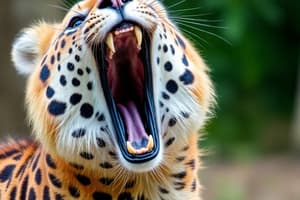Podcast
Questions and Answers
Innate behavior is acquired through experience and observation.
Innate behavior is acquired through experience and observation.
False (B)
Hormonal factors have no influence on animal behavior.
Hormonal factors have no influence on animal behavior.
False (B)
Altruism is a behavior that benefits only the individual.
Altruism is a behavior that benefits only the individual.
False (B)
Vocalizations are a type of chemical signal.
Vocalizations are a type of chemical signal.
Natural selection is a type of proximate cause of animal behavior.
Natural selection is a type of proximate cause of animal behavior.
Flashcards are hidden until you start studying
Study Notes
Types of Animal Behavior
- Innate behavior: Behavior that is present in an individual from birth, without the need for learning or experience. Examples: instinctual migration patterns, mating rituals.
- Learned behavior: Behavior that is acquired through experience, observation, or interaction with the environment. Examples: tool use, problem-solving strategies.
Proximate Causes of Animal Behavior
- Genetic factors: Genetic makeup influences behavior, with certain traits being inherited from parents.
- Environmental factors: Environmental stimuli, such as light, temperature, and social interactions, can trigger specific behaviors.
- Hormonal factors: Hormones, such as testosterone and estrogen, can influence behavior, particularly in relation to reproduction and aggression.
Ultimate Causes of Animal Behavior
- Evolutionary pressures: Behaviors that increase an individual's chances of survival and reproduction are more likely to be passed on to future generations.
- Natural selection: The process by which individuals with favorable traits are more likely to survive and reproduce, leading to the evolution of adaptive behaviors.
Communication in Animal Behavior
- Vocalizations: Sounds used to convey information, such as alarm calls, mating calls, and territorial markers.
- Visual displays: Visual signals, such as body language, postures, and color changes, used to convey information.
- Chemical signals: Pheromones and other chemical cues used to convey information, such as marking territories or attracting mates.
Social Behavior in Animals
- Group living: Animals that live in groups, such as flocks, herds, or colonies, often exhibit cooperative behaviors.
- Cooperation: Behaviors that benefit both the individual and the group, such as hunting together or sharing resources.
- Altruism: Behaviors that benefit others at a personal cost, such as sacrificing one's own life to protect the group.
Foraging and Feeding Behavior
- Optimal foraging theory: The idea that animals optimize their foraging behavior to maximize energy gain while minimizing energy expenditure.
- Food caching: Storing food for later use, often seen in birds and rodents.
- Scavenging: Feeding on carrion or other dead animals.
Mating and Reproductive Behavior
- Mating systems: Monogamy, polygamy, and polyandry are different mating strategies used by animals to maximize reproductive success.
- Courtship behavior: Displays and rituals used to attract a mate, such as singing, dancing, or displaying bright colors.
- Parental care: Care given to offspring by one or both parents, such as feeding, protecting, and teaching.
Types of Animal Behavior
- Innate behavior is present from birth, without needing learning or experience, and includes instinctual migration patterns and mating rituals.
- Learned behavior is acquired through experience, observation, or interaction with the environment, and includes tool use and problem-solving strategies.
Proximate Causes of Animal Behavior
- Genetic factors influence behavior, with certain traits being inherited from parents.
- Environmental factors, such as light, temperature, and social interactions, can trigger specific behaviors.
- Hormonal factors, such as testosterone and estrogen, influence behavior, particularly in relation to reproduction and aggression.
Ultimate Causes of Animal Behavior
- Evolutionary pressures favor behaviors that increase an individual's chances of survival and reproduction, making them more likely to be passed on to future generations.
- Natural selection is the process by which individuals with favorable traits are more likely to survive and reproduce, leading to the evolution of adaptive behaviors.
Communication in Animal Behavior
- Vocalizations, such as alarm calls, mating calls, and territorial markers, convey information through sound.
- Visual displays, such as body language, postures, and color changes, convey information.
- Chemical signals, such as pheromones, convey information about marking territories, attracting mates, and more.
Social Behavior in Animals
- Group living animals, such as flocks, herds, or colonies, often exhibit cooperative behaviors.
- Cooperative behaviors benefit both the individual and the group, such as hunting together or sharing resources.
- Altruistic behaviors benefit others at a personal cost, such as sacrificing one's own life to protect the group.
Foraging and Feeding Behavior
- Optimal foraging theory states that animals optimize their foraging behavior to maximize energy gain while minimizing energy expenditure.
- Food caching involves storing food for later use, often seen in birds and rodents.
- Scavenging involves feeding on carrion or other dead animals.
Mating and Reproductive Behavior
- Mating systems include monogamy, polygamy, and polyandry, which are different strategies used by animals to maximize reproductive success.
- Courtship behavior, such as singing, dancing, or displaying bright colors, is used to attract a mate.
- Parental care involves providing care to offspring, such as feeding, protecting, and teaching.
Studying That Suits You
Use AI to generate personalized quizzes and flashcards to suit your learning preferences.




